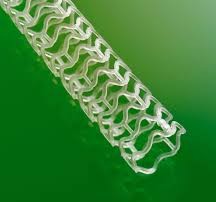Dissolving heart stent clears first major test
14 Oct 2015
A new type of heart stent that works like dissolving stitches and dissolves after doing its job, has passed its first major test, doctors said yesterday.
 Abbott Vascular's dissolving Absorb stent performed on par with a conventional stent in a major one-year study, though, the fact it did not prove superior made some experts wary.
Abbott Vascular's dissolving Absorb stent performed on par with a conventional stent in a major one-year study, though, the fact it did not prove superior made some experts wary.
However, the results on this and other novel stents under testing at present are fueling hope for a new generation of these devices, used on about 850,000 heart disease patients each year in the US alone.
Stents are tiny mesh cages help keep arteries from reclogging following an artery-opening angioplasty procedure. The stents now available in the US are permanent implants made of metal, usually coated with a material that oozes medicine. Inflammation and other problems after some years of use are known to occur.
The Absorb stent, already available in Europe, is made from a degradable material that stayed intact and released medicine for a year, then broke down over the next two years.
"It holds the artery open long enough for the artery to heal" then completely goes away, said one study leader, Dr Dean Kereiakes of Christ Heart and Vascular Center in Cincinnati. "It can return the artery to its normal, natural structure and function," The Associated Press reported.
Absorb is a first-of-its-kind device that functions like a permanent, metallic stent by opening a blocked artery in the heart, restoring blood flow and providing relief from symptoms of coronary artery disease (CAD).
However, unlike a metallic stent, which permanently restricts vessel movement and limits future treatment options, Absorb is made of a naturally dissolvable material that leaves behind a restored vessel in a natural state, free of a permanent implant.
An unrestricted vessel with restored vessel function has the potential to flex, pulse and dilate in response to various demands on the heart, based on people's lifestyle and activities, and allows for potential future treatment options.
"The ABSORB III data shows that there are no statistically significant one-year differences between Absorb and XIENCE, which is a major accomplishment given XIENCE's strong performance as the current standard of care," said Dean Kereiakes, MD, FACC, FSCAI, medical director of The Christ Hospital Heart and Vascular Center and the Lindner Research Center in Cincinnati, professor of clinical medicine at Ohio State University, and a principal investigator of ABSORB III.
"Naturally dissolving heart stents are the next revolution in percutaneous coronary intervention, and Absorb is leading the way as an innovative option. Absorb does its job and then restores the vessel to its natural state over time, which cannot be achieved with a permanent drug eluting stent."
In the September issue of the Journal of Invasive Cardiology, Thomas Jefferson University cardiologists published a warning for physicians and patients alike about an alarming trend they are witnessing first hand – very, very late stent thrombosis. (See: Cardiologists warn of risks for patients with coronary stents who discontinue medications).













.jpg)






.jpg)









